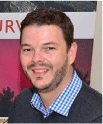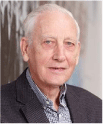Optimising CO2 storage resource utilisation: insights from the Otway Stage 4 field program
Max Watson A * , Hadi Nourollah
A * , Hadi Nourollah  A , David Bason A , Scott Higgs
A , David Bason A , Scott Higgs  A , Sally Benson
A , Sally Benson  B , Peter Cook C , Yong-Chan Park
B , Peter Cook C , Yong-Chan Park  D , Mitch Allison
D , Mitch Allison  A and Ziqiu Xue
A and Ziqiu Xue  E
E
A
B
C
D
E

Max Watson is the Senior Manager for Technology Development at CO2CRC Ltd. and is Australia’s Delegate for the Carbon Sequestration Leadership Forum, a Ministerial-level international climate change initiative. Max has over 23 years of experience in developing industry-relevant, low-emission technologies, including carbon capture, utilisation and storage (CCUS) and, more recently, hydrogen storage. Max has worked in academia, industry, and research and development management sectors, gaining insights from a variety of countries and business types. He completed his PhD at The University of Adelaide. |

Hadi Nourollah is a Senior Geophysicist with 20 years of international experience in Petroleum and carbon capture and storage (CCS) industries. Hadi received his Master’s degree in Petroleum Geosciences at Imperial College, London, and completed his PhD in Geophysics at Curtin University. He has worked for National Oil Companies in the Middle East, operators in SE Asia and directed an international consultancy in Australia for a decade prior to joining the global CCUS leader CO2CRC. |

David Bason is a Reservoir Engineer with CO2CRC in Melbourne, Victoria, with 15 years of experience in the energy industry. David is currently developing the latest research program for Stage 4 carbon dioxide (CO2) experiments at the Otway International Test Centre. David also consults to CO2Tech on various CCUS-focused projects. He holds an MPhys from the University of Manchester, UK, and an MSc in Petroleum Engineering from Heriot-Watt University in Aberdeen, UK. David has previously worked as a Reservoir Engineer for Woodside Energy and as a consultant with EY. |

Scott Higgs is a Reservoir Engineer at CO2CRC, holding a PhD in underground hydrogen storage (UHS). His academic research focused on fluid dynamics in porous media for UHS. Dr. Higgs’ work uncovered critical components that proved the feasibility of UHS in porous media, providing an avenue for large-scale energy storage. Dr Higgs’ dedication to energy security has driven him to explore multiple facets of the energy system, applying nuanced scientific theories to large-scale reservoir engineering problems. Dr Higgs has developed modelling workflows for microbubble technology to enhance CO2 storage and applied his knowledge of advanced reservoir engineering concepts to offshore CO2 storage projects. Dr. Higgs continues to lead the way in shaping the future of energy storage through innovative research, combining academic excellence with practical solutions for a more sustainable and secure energy future. |

Sally Benson is a distinguished scientist and science leader in clean energy innovation, including CCS. She has recently completed 2 years as the Energy Division Director and Chief Strategist for the Energy Transition, within the White House Office of Science and Technology Policy. Professor Benson obtained a BA from Barnard College and an MSc and PhD from UC Berkeley. She occupied several senior positions at the Lawrence Berkeley National Laboratory. In 2007, she took up a senior academic appointment at Stanford University as Director of Global Climate and Energy Project and then the Precourt Institute of Energy. Professor Benson has authored many research papers and energy reviews. She has had a long involvement in Australian CCS research, first as an Intergovernmental Panel on Climate Change (IPCC) Coordinating Lead Author, more recently as Co-Director of the GeoCquest international collaborative project, and now of the GeoCquest Field Validation project. |

Peter Cook is an eminent Australian and international Earth Scientist and a leader in CCS research. A sedimentary geologist by training, he holds the degrees of BSc (Hons), MSc, PhD and DSc and has received a number of awards and honours in recognition of his contribution to science, including the Lewis G Weekes Gold Medal of APPEA. He is a Fellow of the Academy of Technological Sciences and Engineering and has held academic and research positions in the UK, France, USA, and Australia. He has been an IPCC Co-ordinating Lead Author. He has also chaired major government reviews of unconventional gas. Currently, he is a Professorial Fellow at the University of Melbourne Centre for CCS Research, CO2CRC Distinguished Scientist, a member of advisory boards, consultant to companies and governments, as well as Co-Chair of the BHP-supported Melbourne-Stanford-Cambridge GeoCquest Project. |

Yong-Chan Park is a Principal Researcher at the Korea Institute of Geoscience and Mineral Resources within the CO2 Geological Storage Research Center. He earned his PhD in Petroleum Engineering from Hanyang University in Seoul, South Korea. Yong-Chan is a member of the Society of Petroleum Engineers as well as the European Association of Geoscientists and Engineers. |

Mitch Allison graduated from the University of Guelph in 2005 with a BSc in Geology. He is an experienced geologist and project manager who has worked in oil and gas exploration and development in Canada and Australia for 18 years. Last November, he accepted a role with CO2CRC as a Geoscientist and earlier this year, moved into the Operations Manager role. Mitch is a current member of the American Association of Petroleum Geologists and the Society of Petroleum Engineers. |

Ziqiu Xue is a Chief Researcher at the Research Institute of Innovative Technology for the Earth. He started his professional career in carbon sequestration in 2000. He was responsible for CO2 monitoring at the first Japanese pilot-scale saline aquifer storage project (Nagaoka project). Ziqiu Xue has teaching experience in Kyoto University. He served as an Associate Editor of International Journal of Greenhouse Gas Control during 2007–2012. He received a BS, MS and PhD degree in Faculty Engineering from Hokkaido University, as well as a best paper award from Society of Exploration Geophysicists of Japan in 2006. |
Abstract
The optimised utilisation of storage resources and accelerated commercial carbon dioxide (CO2) storage development is vital for carbon capture and storage to play its important role in reducing emissions at scale. CO2CRC seeks to address this challenge through an international collaboration – the Otway Stage 4 field program – that demonstrates a suite of cost-effective reservoir management techniques with the potential to improve CO2 storage capabilities, particularly in lower-quality reservoirs, maturing them for commercial readiness. Aiming to enhance injectivity, improve sweep, increase model resolution, and develop performance monitoring capabilities, Otway 4 will substantially improve CO2 storage resource usage, furthering economical viability for decreasing CO2 emissions to the atmosphere. Otway Stage 4 includes acquisition and analysis of CO2 saturation and chemical data during plume migration and trapping, combined with investigation of fine-scale geological heterogeneity’s role in CO2 flow dynamics, to refine modelling workflows and, ultimately, develop strategies for optimising commercial CO2 storage; demonstrating whether CO2 microbubbles (MBs) significantly increase storage efficiency compared to standard CO2 injection, thereby unlocking previously untenable reservoirs for CO2 storage; enhancing seismic monitoring to comprehensively assess storage performance and MB behaviour, including quantitative derivation of CO2 saturation; and demonstrating the capability of Distributed Strain Sensing to quantitatively measure geomechanical changes associated with CO2 injection. In addition to Otway 4’s forward plans, laboratory and modelling work, including core flood analysis, to understand CO2 MB and surfactant behaviour at pore scale, dynamic modelling of CO2 flow through heterogeneous reservoir, and selecting suitable injection intervals at the Otway site are discussed.
Keywords: CO2 storage, fibre optics, geological modelling, heterogeneous, microbubble, optimisation, otway, pore space, reservoir modelling, seismic, surfactant, utilisation.
 Max Watson is the Senior Manager for Technology Development at CO2CRC Ltd. and is Australia’s Delegate for the Carbon Sequestration Leadership Forum, a Ministerial-level international climate change initiative. Max has over 23 years of experience in developing industry-relevant, low-emission technologies, including carbon capture, utilisation and storage (CCUS) and, more recently, hydrogen storage. Max has worked in academia, industry, and research and development management sectors, gaining insights from a variety of countries and business types. He completed his PhD at The University of Adelaide. |
 Hadi Nourollah is a Senior Geophysicist with 20 years of international experience in Petroleum and carbon capture and storage (CCS) industries. Hadi received his Master’s degree in Petroleum Geosciences at Imperial College, London, and completed his PhD in Geophysics at Curtin University. He has worked for National Oil Companies in the Middle East, operators in SE Asia and directed an international consultancy in Australia for a decade prior to joining the global CCUS leader CO2CRC. |
 David Bason is a Reservoir Engineer with CO2CRC in Melbourne, Victoria, with 15 years of experience in the energy industry. David is currently developing the latest research program for Stage 4 carbon dioxide (CO2) experiments at the Otway International Test Centre. David also consults to CO2Tech on various CCUS-focused projects. He holds an MPhys from the University of Manchester, UK, and an MSc in Petroleum Engineering from Heriot-Watt University in Aberdeen, UK. David has previously worked as a Reservoir Engineer for Woodside Energy and as a consultant with EY. |
 Scott Higgs is a Reservoir Engineer at CO2CRC, holding a PhD in underground hydrogen storage (UHS). His academic research focused on fluid dynamics in porous media for UHS. Dr. Higgs’ work uncovered critical components that proved the feasibility of UHS in porous media, providing an avenue for large-scale energy storage. Dr Higgs’ dedication to energy security has driven him to explore multiple facets of the energy system, applying nuanced scientific theories to large-scale reservoir engineering problems. Dr Higgs has developed modelling workflows for microbubble technology to enhance CO2 storage and applied his knowledge of advanced reservoir engineering concepts to offshore CO2 storage projects. Dr. Higgs continues to lead the way in shaping the future of energy storage through innovative research, combining academic excellence with practical solutions for a more sustainable and secure energy future. |
 Sally Benson is a distinguished scientist and science leader in clean energy innovation, including CCS. She has recently completed 2 years as the Energy Division Director and Chief Strategist for the Energy Transition, within the White House Office of Science and Technology Policy. Professor Benson obtained a BA from Barnard College and an MSc and PhD from UC Berkeley. She occupied several senior positions at the Lawrence Berkeley National Laboratory. In 2007, she took up a senior academic appointment at Stanford University as Director of Global Climate and Energy Project and then the Precourt Institute of Energy. Professor Benson has authored many research papers and energy reviews. She has had a long involvement in Australian CCS research, first as an Intergovernmental Panel on Climate Change (IPCC) Coordinating Lead Author, more recently as Co-Director of the GeoCquest international collaborative project, and now of the GeoCquest Field Validation project. |
 Peter Cook is an eminent Australian and international Earth Scientist and a leader in CCS research. A sedimentary geologist by training, he holds the degrees of BSc (Hons), MSc, PhD and DSc and has received a number of awards and honours in recognition of his contribution to science, including the Lewis G Weekes Gold Medal of APPEA. He is a Fellow of the Academy of Technological Sciences and Engineering and has held academic and research positions in the UK, France, USA, and Australia. He has been an IPCC Co-ordinating Lead Author. He has also chaired major government reviews of unconventional gas. Currently, he is a Professorial Fellow at the University of Melbourne Centre for CCS Research, CO2CRC Distinguished Scientist, a member of advisory boards, consultant to companies and governments, as well as Co-Chair of the BHP-supported Melbourne-Stanford-Cambridge GeoCquest Project. |
 Yong-Chan Park is a Principal Researcher at the Korea Institute of Geoscience and Mineral Resources within the CO2 Geological Storage Research Center. He earned his PhD in Petroleum Engineering from Hanyang University in Seoul, South Korea. Yong-Chan is a member of the Society of Petroleum Engineers as well as the European Association of Geoscientists and Engineers. |
 Mitch Allison graduated from the University of Guelph in 2005 with a BSc in Geology. He is an experienced geologist and project manager who has worked in oil and gas exploration and development in Canada and Australia for 18 years. Last November, he accepted a role with CO2CRC as a Geoscientist and earlier this year, moved into the Operations Manager role. Mitch is a current member of the American Association of Petroleum Geologists and the Society of Petroleum Engineers. |
 Ziqiu Xue is a Chief Researcher at the Research Institute of Innovative Technology for the Earth. He started his professional career in carbon sequestration in 2000. He was responsible for CO2 monitoring at the first Japanese pilot-scale saline aquifer storage project (Nagaoka project). Ziqiu Xue has teaching experience in Kyoto University. He served as an Associate Editor of International Journal of Greenhouse Gas Control during 2007–2012. He received a BS, MS and PhD degree in Faculty Engineering from Hokkaido University, as well as a best paper award from Society of Exploration Geophysicists of Japan in 2006. |
References
Amer R, Xue Z, Hashimoto T, Nagata T (2021) Distributed Fiber Optic Strain Sensing for Geomechanical Monitoring: Insights from Field Measurements of Ground Surface Deformation. Geosciences 11(7), 285.
| Crossref | Google Scholar |
Cook P, Benson S, Haese R, Boon M, Neufeld J, Ni C, Bickle M, Benham G, Sahu C, Matthai S, Jyoti A, Kurtev K, Mishra A, Shao Q, Youssef A, Watson M (2020). ‘GeoCquest: Quantifying the impact of heterogeneity on CO2 trapping, storage capacity and injectivity’. CO2CRC Publication Number RPT21-6311. (CO2CRC Ltd.: Melbourne, Australia)
CSLF (2019) Improved Pore Space Utilisation: Current Status of Techniques. Carbon Sequestration Leadership Forum (CSLF) Technical Group Task Force on Improved Pore Space Utilisation. 49 p. Available at https://www.cslforum.org/cslf/
Glubokovskikh S, Pevzner R, Dance T, Caspari E, Popik D, Shulakova V, Gurevich B (2016) Seismic monitoring of CO2 geosequestration: CO2CRC Otway case study using full 4D FDTD approach. International Journal of Greenhouse Gas Control 49, 201-216.
| Crossref | Google Scholar |
Jiang L, Xue Z, Park H (2019) Enhancement of CO2 dissolution and sweep efficiency in saline aquifer by micro bubble CO2 injection. International Journal of Heat and Mass Transfer 138, 1211-1221.
| Crossref | Google Scholar |
Kim S, Santamarina J (2014) Engineered CO2 injection: The use of surfactants for enhanced sweep efficiency. International Journal of Greenhouse Gas Control 20, 324-332.
| Crossref | Google Scholar |
OGCI (2022) CO2 Storage Resource Catalogue – Report 2022. Available at https://www.ogci.com/wp-content/uploads/2023/04/CSRC_Cycle_3_Main_Report_Final.pdf
Park Y-C, Kim S, Lee JH, Shinn YJ (2019) Effect of reducing irreducible water saturation in a near-well region on CO2 injectivity and storage capacity. International Journal of Greenhouse Gas Control 86, 134-145.
| Crossref | Google Scholar |
Paterson L, Boreham C, Bunch M, Dance T, Ennis-King J, Freifeld B, Haese R, Jenkins C, LaForce T, Raab M, Singh R, Stalker L, Zhang Y (2013) Overview of the CO2CRC Otway residual saturation and dissolution test. Energy Procedia 37, 6140-6148.
| Crossref | Google Scholar |
Pevzner R, Glubokovskikh S, Isaenkov R, Shashkin P, Tertyshnikov K, Yavuz S, Gurevich B, Correa J, Wood T, Freifeld B (2022) Monitoring subsurface changes by tracking direct-wave amplitudes and traveltimes in continuous distributed acoustic sensor VSP data. Geophysics 87, A1-A6.
| Crossref | Google Scholar |
Piccolo A, Delepine-Lesoille S, Leduc D, Lecieux Y (2019) Distributed optical fiber strain and temperature sensing system performances: Brillouin vs Rayleigh. In ‘Proceedings of the Seventh European Workshop on Optical Fibre Sensors’, Limassol, Cyrus, 1–4 October 2019. (Eds K Kalli, S O’Keeffe, G Brambilla) Available at https://www.spiedigitallibrary.org/conference-proceedings-of-spie/11199.toc
Ringrose PS, Mathieson AS, Wright IW, Selama F, Hansen O, Bissell R, Saoula N, Midgley J (2013) The In Salah CO2 Storage Project: Lessons Learned and Knowledge Transfer. Energy Procedia 37, 6226-6236.
| Crossref | Google Scholar |
Seok GB, Park Y-C, Lee JY, Lee YK, Kim KY, Son H, Raab M (2023) Impact of surfactants on CO2-brine relative permeability under reservoir conditions. Energy Reports 9, 3755-3770.
| Crossref | Google Scholar |
Xue Z, Ueda R, Nakano M (2021) Field application of microbubble CO2 injection for enhanced storage efficiency in a tight sandstone reservoir. In ‘15th International Conference on Greenhouse Gas Control Technologies, GHGT-15’, Abu Dhabi, UAE, 15–18 March 2021. http://dx.doi.org/10.2139/ssrn.3811983
Yoshida N, Levine JS, Stauffer PH (2016) Investigation of uncertainty in CO2 reservoir models: A sensitivity analysis of relative permeability parameter values. International Journal of Greenhouse Gas Control 49, 161-178.
| Crossref | Google Scholar |
Zhai H, Xue Z, Park H, Aizawa Y, Baba Y (2020) Migration characteristics of supercritical CO2 microbubble flow in the Berea sandstone revealed by voxel-based X-ray computed tomography imaging analysis. Journal of Natural Gas Science and Engineering 77, 103233.
| Crossref | Google Scholar |
Zhang C, Wang M (2023) CO2/brine interfacial tension for geological CO2 storage: A systematic review. Journal of Petroleum Science and Engineering 220, 111154.
| Crossref | Google Scholar |
Zhu Y, Chen G (2022) Rayleigh scattering based, thermal-induced displacement measurement along a steel plate at high temperature. Journal of Infrastructure Intelligence and Resilience 1, 100002.
| Crossref | Google Scholar |


